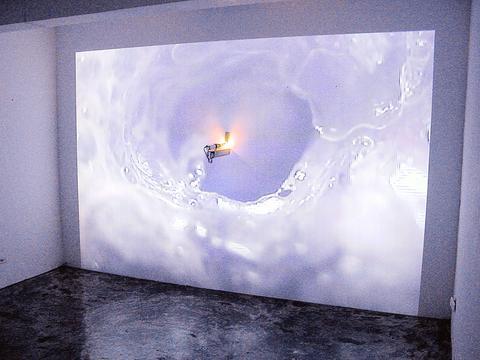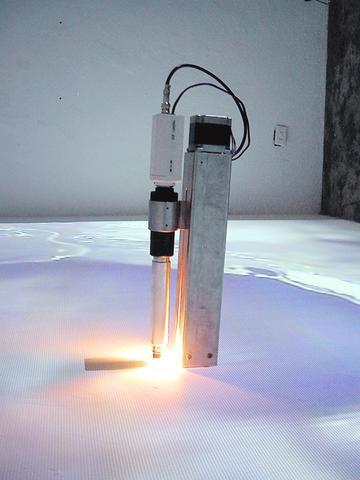In the information age, it's all too easy to sit at one's computer screen all day and night, clicking from one link to another, going with the flow, surrendering oneself to the overwhelming deluge of facts and opinion -- taking leave of one's physical existence in the here and now.
So as to remind people of their physical existence, 37-year-old artist Tao Ya-lun (

PHOTO COURTESY OF IT PARK
The title has paradoxical meanings for Tao. "Consciousness in Vacuum is the letting go of your [information-absorbing] brain and taking a look at your body and the things around it. It also means the continual taking in of rapid streams of information, which propels the brain to function so fervently that it breaks down altogether."

PHOTO COURTESY OF IT PARK
With this paradoxical concept in mind, Tao takes an ambivalent attitude in showing his installations. The piece that greets viewers in the gallery is a video projection of a series of changing images from a "sticky" 1m2 space on the floor. From the opening of the exhibition to the third day, the images have turned from small bubbles on a white background to amorphous dots on a grey background. Few visitors, Tao said, knew that the images they stepped across on the sticky floor were the miscellaneous bits of dirt which their shoes had just left behind on the glued floor. By fixing a microscope lens on the camera directed at the glued floor and projecting the image onto it, Tao has created images of a constellation of dirt against the background of real accumulated dirt.
Having provided a minimal introduction to his piece at the gallery, most have mistaken it for pre-recorded images.
"[Dirt on one's shoes] is something that is always present, and yet always eludes one's consciousness because it's infinitesimal," Tao said.
Although the way Tao's camera and projector are set up gave viewers no clues as to what they were looking at, if they found out they were said to be baffled at first, and then struck by the realization that there are some physical existences around them they never noticed before.
"Optic fiber and the illusion of distance made possible by the technology, particularly regarding images, have gradually obliterated our awareness of concrete objects and of our body. It's like the invention of perspective in painting replaced our tangible sense of vision during the Renaissance. There has been a gap between the brain and the body," Tao said.
The other piece may not as inspiring but is just as intriguing. Using a similar imaging device, an image of a glue-tipped needle moving to and fro inside a pinhole is magnified and projected onto the pin-holed wall. Complete with sensors, the projection appears only when the viewer has walked up to the pinhole on the wall.
Well-known for his mechanical petroleum pool installation, which simulates the circle of life and death in nature, Tao in Consciousness Vacuum is making another attempt at "ascertaining the spiritual through coming face to face with the physical." This looking at the physical requires viewers to slow down their habitually frantic pace, as Tao's works are rarely active and vivacious and offer the least possible amount of information in terms of images. They require a lot of feeling and the letting go of the thirst for information.
Consciousness Vacuum:
Tao Ya-lun's Solo Exhibition" runs until Aug. 2 at IT Park, 41, 2/3F I-Tong Street Taipei (

On April 26, The Lancet published a letter from two doctors at Taichung-based China Medical University Hospital (CMUH) warning that “Taiwan’s Health Care System is on the Brink of Collapse.” The authors said that “Years of policy inaction and mismanagement of resources have led to the National Health Insurance system operating under unsustainable conditions.” The pushback was immediate. Errors in the paper were quickly identified and publicized, to discredit the authors (the hospital apologized). CNA reported that CMUH said the letter described Taiwan in 2021 as having 62 nurses per 10,000 people, when the correct number was 78 nurses per 10,000

As we live longer, our risk of cognitive impairment is increasing. How can we delay the onset of symptoms? Do we have to give up every indulgence or can small changes make a difference? We asked neurologists for tips on how to keep our brains healthy for life. TAKE CARE OF YOUR HEALTH “All of the sensible things that apply to bodily health apply to brain health,” says Suzanne O’Sullivan, a consultant in neurology at the National Hospital for Neurology and Neurosurgery in London, and the author of The Age of Diagnosis. “When you’re 20, you can get away with absolute

When the South Vietnamese capital of Saigon fell to the North Vietnamese forces 50 years ago this week, it prompted a mass exodus of some 2 million people — hundreds of thousands fleeing perilously on small boats across open water to escape the communist regime. Many ultimately settled in Southern California’s Orange County in an area now known as “Little Saigon,” not far from Marine Corps Base Camp Pendleton, where the first refugees were airlifted upon reaching the US. The diaspora now also has significant populations in Virginia, Texas and Washington state, as well as in countries including France and Australia.

May 5 to May 11 What started out as friction between Taiwanese students at Taichung First High School and a Japanese head cook escalated dramatically over the first two weeks of May 1927. It began on April 30 when the cook’s wife knew that lotus starch used in that night’s dinner had rat feces in it, but failed to inform staff until the meal was already prepared. The students believed that her silence was intentional, and filed a complaint. The school’s Japanese administrators sided with the cook’s family, dismissing the students as troublemakers and clamping down on their freedoms — with